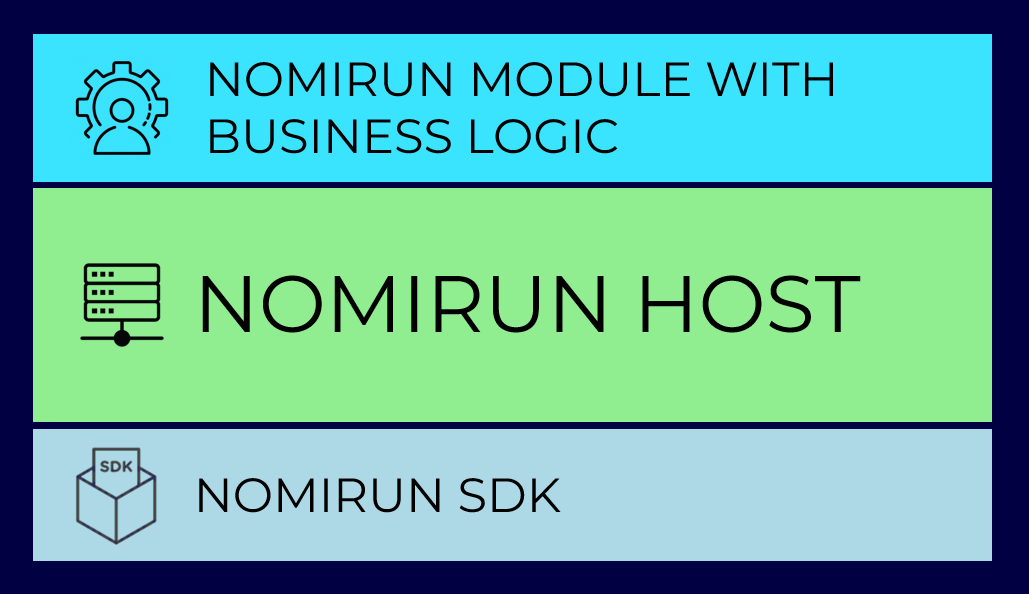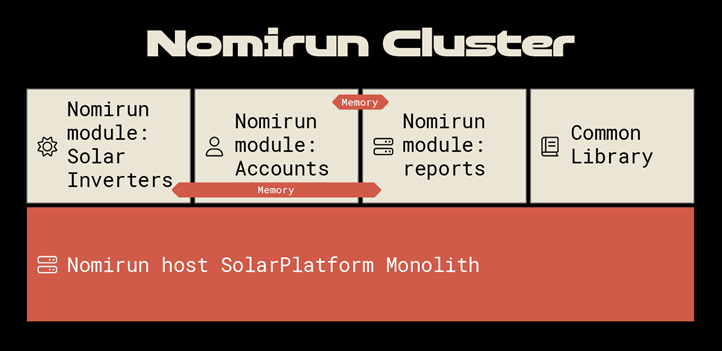Nomirun Architecture
Table of Contents
- Non-Generic Host Service Architecture
- Nomirun (generic host) Architecture
- Nomirun Host as a Modular Monolith
- Nomirun Host as a Microservice
- Nomirun Host as a Hybrid Architecture
Non-Generic Host Service Architecture
While modern .NET applications often benefit from using a generic host, some teams may still opt for a non-generic service architecture. However, this approach can lead to additional complexity, less flexibility, and reduced extensibility compared to leveraging a generic host. Generic hosts provide built-in dependency injection, configuration management, and lifecycle control, making services more maintainable and scalable. Below is an outline of key architectural considerations for implementing a structured .NET service when avoiding a generic host.

Key Architectural Components
Business Logic: Encapsulates core application rules and workflows. It is typically implemented using service classes that interact with data repositories and external systems to process requests.
Tracing: Provides insights into service execution flows, helping diagnose performance issues and errors. In .NET, OpenTelemetry or Application Insights can be used to track request lifecycles across distributed services.
Logs: Captures structured and unstructured data about system behavior. Serilog, NLog, or Microsoft.Extensions.Logging are commonly used to implement logging strategies.
Metrics: Enables monitoring of service performance and resource usage. Tools like Prometheus, Grafana, or Azure Monitor help collect and analyze operational data.
Health Endpoints: Expose the service’s health status for monitoring tools. In .NET, the AspNetCore.Diagnostics.HealthChecks library can provide readiness and liveness checks.
Caching: Improves performance by storing frequently accessed data in memory or distributed caches like Redis or MemoryCache to reduce database load.
Swagger: Provides interactive API documentation and testing capabilities using Swashbuckle or NSwag. It generates OpenAPI specifications automatically.
Config: Manages application settings using appsettings.json, environment variables, or configuration providers like Azure App Configuration.
Secrets: Stores and accesses sensitive information securely using Azure Key Vault, HashiCorp Vault, or .NET’s built-in user secrets manager.
Service Discovery: Allows services to dynamically locate each other in distributed environments using tools like Consul, Eureka, or Kubernetes service discovery.
Throttling: Prevents abuse and ensures fair resource distribution by implementing rate limiting using libraries like AspNetCoreRateLimit or API gateway policies.
Shared Code Packages: Encapsulates reusable components and utilities into NuGet packages or internal shared libraries to maintain consistency and reduce duplication.
A well-structured non-generic service architecture in .NET can still be effective but often lacks the built-in advantages provided by a generic host. Teams should carefully evaluate their choice, as a generic host typically simplifies service development and enhances maintainability in modern cloud-native applications.
Nomirun (Generic Host) Architecture
For modern .NET applications, using a generic host like Nomirun is the preferred approach. Nomirun abstracts away infrastructure concerns such as dependency injection, configuration, logging, and monitoring, allowing developers to focus purely on business logic. With the Nomirun SDK, teams can easily integrate essential service capabilities without manually managing these concerns. Business logic is encapsulated in Nomirun Modules, ensuring clean separation and maintainability.
On the side, there is a Nomirun CLI to support your workflows and tasks.

Nomirun is highly flexible, capable of being used as a modular monolith or as a set of microservices, allowing teams to scale their applications based on their needs while maintaining a consistent architecture.
Nomirun Host as a Modular Monolith
Begin by designing Nomirun Modules that align with your application’s specific needs. These modules encapsulate business logic and can be structured to reflect the domains of your system.
As your understanding of the domain evolves, you can refine your architecture by splitting larger modules into smaller, more focused ones or merging related modules to simplify interactions. This flexibility ensures that your architecture remains adaptable and maintainable.
Once your modules are well-defined, you can bundle them together within a modular monolith, running them seamlessly within a single Nomirun Host.

Upon deploying to production, you may identify opportunities to optimize performance—such as reducing memory consumption by decomposing modules further into independent services. Whether for scalability, resource efficiency, or organizational needs, Nomirun allows you to evolve your architecture dynamically without introducing unnecessary complexity.
Nomirun Host as a Microservice
Upon deploying to production, you may identify opportunities to optimize performance—such as reducing memory consumption by decomposing modules further into independent services. Whether for scalability, resource efficiency, or organizational needs, Nomirun allows you to evolve your architecture dynamically without introducing unnecessary complexity.
If your application demands further scalability, breaking the modular monolith into independent microservices is a seamless transition. Using the Nomirun CLI, you can configure and deploy multiple Nomirun Hosts, each running a distinct microservice.

This transformation requires no code changes or recompilation—only a configuration update. The primary adjustment is within your deployment scripts, as you’ll now manage multiple services instead of one. However, since the underlying architecture remains consistent, adapting your deployment process is straightforward and efficient.
Nomirun Host as a Hybrid Architecture
Nomirun’s flexibility allows for a hybrid architecture that combines the simplicity of a monolith with the scalability of microservices. You can run specific sets of cohesive modules within a single Nomirun Host while deploying other, high-demand modules as independent services.
This approach enables you to isolate “noisy neighbors” or scale specific domains independently without incurring the operational overhead of managing a full microservices landscape.

Like the other models, adopting a hybrid architecture is achieved solely through configuration. You can dynamically regroup modules into different hosts as performance metrics or organizational structures dictate, maintaining a highly responsive and efficient system.